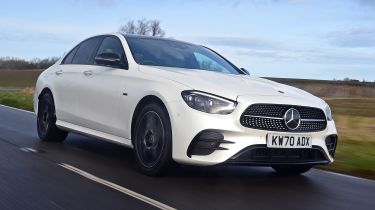Mercedes E-Class (2016-2023) - MPG, CO2 and running costs
The Mercedes E-Class plug-in hybrid model makes greats sense for business users

Just so you know, this is an older review of the 2016-2023 Mercedes E-Class. If you are interested in information about how much it'll cost to run a new Mercedes E-Class, or news about the latest Mercedes models, please follow the links provided.
Not only is the 2.0-litre diesel in the E 220 d faster and more refined, it’s also more efficient. Claimed combined fuel economy is 57.7mpg under WLTP testing, with CO2 emissions are now 128g/km.
Opt for the E 400 d and the vital figures aren’t quite as impressive, with a claimed maximum of 42.2mpg and CO2 emissions of 176g/km, but this is still fairly competitive efficiency compared to its rivals and good considering the level of performance on offer. However, you'll be spending even more time at the filling station if you choose the petrol E 450 4MATIC - its 3.0-litre six-cylinder unit returns just 31.4mpg on the combined cycle.
The E 53 AMG manages 30.4mpg and 215g/km of CO2, which again is impressive for such a powerful motor - but in the real world those figures will be some way off, especially if you're driving it as intended.
The E 300 e and E 300 de are the most efficient of the bunch, emitting between 33 and 40g/km of CO2, and remember that if you can make use of the 30-mile plus electric range then you won't use a single drop of fuel.
Used - available now

2022 Mercedes
E Class
44,201 milesAutomaticPetrol2.0L
Cash £25,800
2020 Mercedes
E Class
56,910 milesAutomaticDiesel2.0L
Cash £22,700
2019 Mercedes
E Class
42,198 milesAutomaticDiesel2.0L
Cash £15,720
2020 Mercedes
E Class
16,426 milesAutomaticDiesel2.0L
Cash £30,587All cars get stop-start to help reduce tailpipe emissions, while other features such as clever aerodynamics further improve efficiency. The new E-Class has a drag coefficient of 0.23 Cd, which is actually 0.01 lower than the latest Toyota Prius, an already very aerodynamically advanced vehicle, showing how well the Merc slips through the air, using less fuel in the process.
Insurance groups
The entry-level E 200 Sport is rated at group 34, while AMG Line trim takes this up to group 36 for both the petrol and E 220 d diesel versions. The top-of-the-range E 63 S will predictably incur expensive premiums being in group 49. The popular
Insurance groups for the E 300 e and E 300 de are also higher because of the expensive hybrid tech and the potential for increased repair costs following an accident. In AMG Line trim, they sit in groups 44 and 46 respectively.
Depreciation
With predicted residual values hovering around 44 per cent (after three-years and 36,000 miles of motoring), the fifth-generation E-Class isn't as strong as you might think when it comes to depreciation. The plug-in hybrid models fare a little better than the rest of the range, holding onto 45-46 per cent of their original list price after three-years and 36,000 miles.
More reviews
Car group tests
In-depth reviews
Road tests
Used car tests
Which Is Best
Fastest
- NameE450d 4M AMG Line Premium 4dr 9G-Tronic [Pan Roof]
- Gearbox typeSemi-auto
- RRP£79,870










